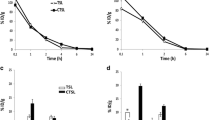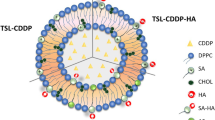Abstract
To evaluate the rate of drug release at the tumor and maximal drug targeting after administration of thermosensitive liposomes with hy-perthermia, a theoretical and experimental method was derived assessing the fraction of drug released from liposomes in a single pass through the heated tumor, F, and the drug targeting index when drug release occurs completely in response to heat (F = 1), DTImax. The F and DTImax were evaluated for four types of liposomes (LUV-1 and LUV-2, thermosensitive large unilamellar liposomes; LUV-3, a nonthermosensitive large unilamellar liposome; and SUV-1, a thermosensitive small unilamellar liposome) using reported data on blood liposome levels and tumor drug levels after the liposomes were administered to tumor bearing mice. DTImax values for LUV-1 and SUV-1 were approximately 6, while the value for LUV-2 with a relatively large systemic clearance was only 2.3. The F values for LUV-1, LUV-2, and SUV-1 with hyperthermia were 0.71, 1.17, and 0.34, respectively, whereas the values for these liposomes without hyperthermia and for LUV-3 with or without hyperthermia were nearly zero. These results confirm earlier findings that LUV-1 and LUV-2 release CDDP almost completely at the heated tumor and that the large DTI value obtained in LUV-1 (DTI = 4.6) was due to its high heat sensitivity and its small systemic clearance.
Similar content being viewed by others
REFERENCES
M. B. Yatvin, J. N. Weinstein, W. H. Dennis, and R. Blumenthal. Design of liposomes for enhanced local release of drugs by hyperthermia. Science 202:1290–1293 (1978).
J. N. Weinstein, R. L. Magin, R. L. Cysyl, and D. S. Zaharko. Treatment of solid L1210 murine tumors with local hyperthermia and temperature-sensitive liposomes containing methotrexate. Cancer Res. 40:1388–1395 (1980).
K. Iga, N. Hamaguchi, Y. Igari, Y. Ogawa, H. Toguchi, and T. Shimamoto. Heat-specific drug-release of large unilamellar vesicle as hyperthermia-mediated targeting delivery. Int. J. Pharm. 57:241–251 (1989).
K. Iga, N. Hamaguchi, Y. Igari, Y. Ogawa, H. Toguchi, and T. Shimamoto. Increased tumor cisplatin levels in heated tumor in mice after administration of thermosensitive large unilamellar vesicles encapsulating cisplatin. J. Pharm. Sci. 80:522–525 (1991).
K. Iga, N. Hamaguchi, Y. Igari, Y. Ogawa, K. Goto, K. Ootsu, H. Toguchi, and T. Shimamoto. Enhanced antitumor activity in mice after administration of thermosensitive liposome encapsulating cisplatin with hyperthermia. J. Pharmacol. Exp. Ther. 257:1203–1207 (1991).
S. Oie and J.-D. Huang. Influence of administration route on drug delivery to a target organ. J. Pharm. Sci. 70:1344–1347 (1981).
C. A. Hunt, R. D. MacGregor, and R. A. Siegel. Engineering targeted in vivo drug delivery. I. Therapeutical and physicochemical principles governing opportunities and limitations. Pharm. Res. 3:333–344 (1986).
A. Boddy, L. Aarons, and K. Petrak. Efficiency of targeting: Steady-state considerations using a three-compartmental model. Pharm. Res. 6:367–372 (1989).
P. K. Gupta and C. T. Hung. Quantitative evaluation of targeted drug delivery systems. Int. J. Pharm. 56:217–226 (1989).
S. Awazu, T. Oguma, T. Iga, and M. Hanano. Generalized consideration of administration route dependency of drug disposition and use of urinary data for prediction of the dependence. Chem. Pharm. Bull. 25:680–689 (1977).
H.-S. G. Chen and J. F. Gross. Estimation of tissue-to-plasma partition coefficients used in physiological pharmacokinetic models. J. Pharmcokin. Biopharm. 7:117–125 (1979).
Y. Igari, Y. Sugiyama, Y. Sawada, T. Iga, and M. Hanano. Prediction of diazepam disposition in rat and man by a physiological based pharmacokinetic model. J. Pharmcokin. Biopharm. 11:577–598 (1983).
T. M. Allen, C. Hansen, and J. Rutledge. Liposomes with prolonged circulation times: Factors affecting uptake by reticuloendothelial and other tissues. Biochim. Biophys. Acta 981:27–35 (1989).
G. Gregoliadis. Fate of injected liposomes: Observations on entrapped solute retention, vesicle clearance and tissue distribution in vivo. In G. Gregoliadis (ed.), Liposomes as Drug Carriers, John Wiley and Sons, New York, 1988, pp. 3–18.
Author information
Authors and Affiliations
Rights and permissions
About this article
Cite this article
Iga, K., Ogawa, Y. & Toguchi, H. Heat-Induced Drug Release Rate and Maximal Targeting Index of Thermosensitive Liposome in Tumor-Bearing Mice. Pharm Res 9, 658–662 (1992). https://doi.org/10.1023/A:1015858228394
Issue Date:
DOI: https://doi.org/10.1023/A:1015858228394




